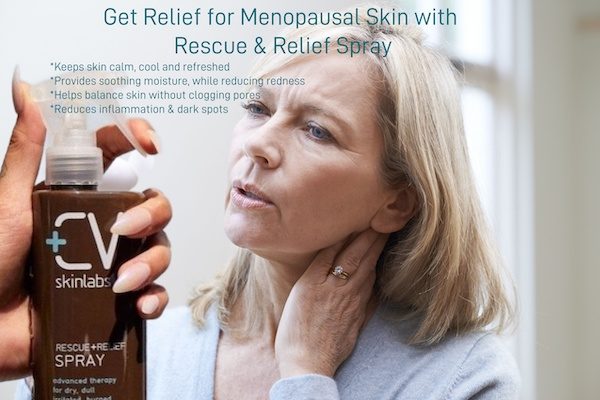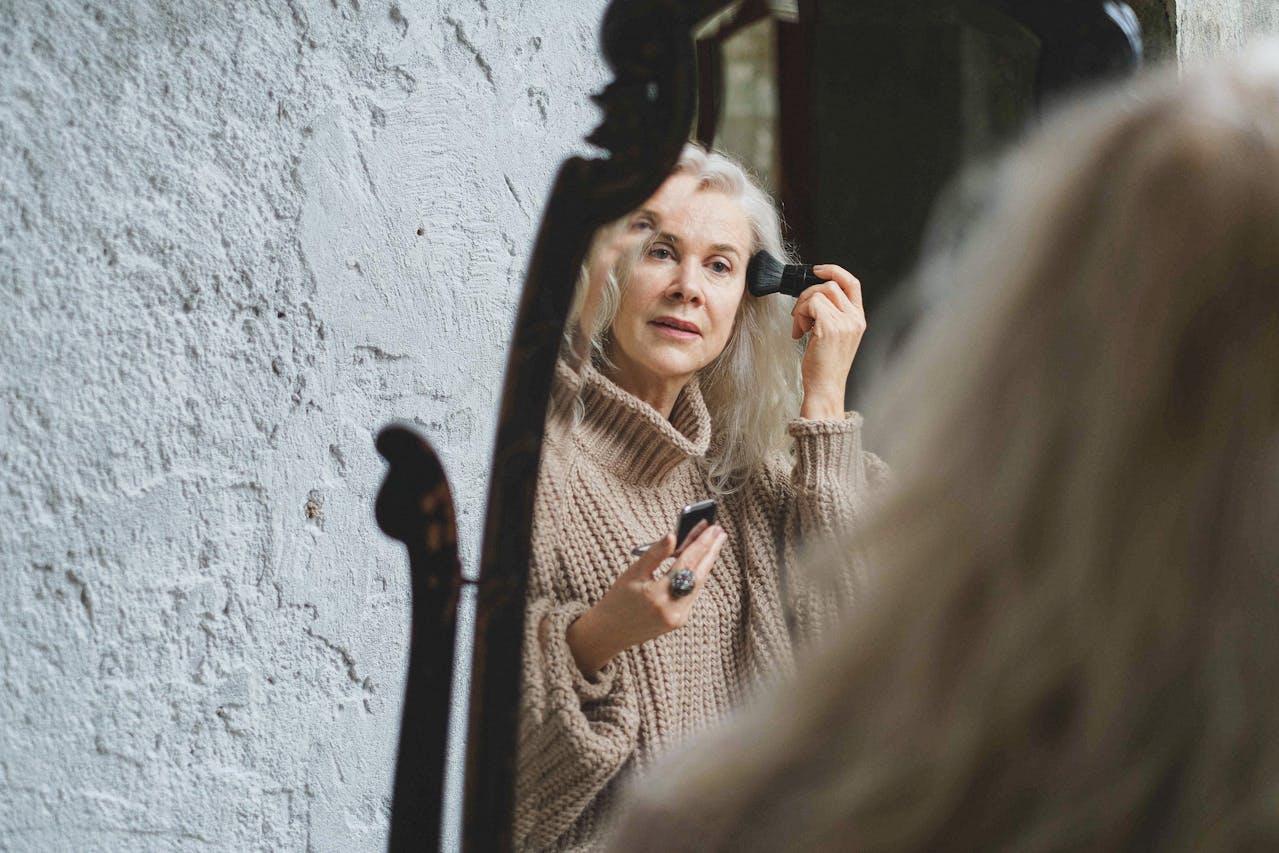If you are approaching or already going through the age of menopause, you may have noticed menopausal skin changes.
Hormonal shifts in the body can affect the skin. If you’re seeing increased dryness, breakouts, itching, signs of aging, or sensitivity, you’re not alone. Many women suffer from these symptoms.
Fortunately, there are several things you can do to help your skin get through this period better.
What causes skin changes in menopause?
Hormonal shifts are the main cause of menopausal skin changes. As your periods slow and stop, the body experiences a significant drop in estrogen levels. Estrogen is the female reproductive hormone that regulates the menstrual cycle, but it does many other things too.
Indeed, affects estrogen the reproductive system, but also the urinary tract, heart and blood vessels, bones, breasts, skin, hair, mucous membranes, pelvic muscles and brain! It has several positive effects, such as protecting the heart and brain from inflammation and disease, improving muscle mass, improving mood, and keeping the vagina lubricated so sex is enjoyable.
Estrogen also helps with diabetes prevention of skin aging. It helps slow the decline of collagen, which gives structure to the skin. It also retains skin moisture, which can help prevent dryness and reduce wrinkles.
During premenopause and menopause, estrogen levels drop. That’s the cause of most uncomfortable symptoms, including vaginal dryness, mood swings, night sweats and hot flashes.
Other hormones involved in menopausal skin changes
Progesterone is another female reproductive hormone that decreases during menopause. During childbearing years, it is involved in pregnancy and also affects menstruation. During menopause, the body gradually stops producing progesterone. This causes symptoms such as headaches, mood swings, hot flashes, sleep problems and weight gain. It can also affect the skin.
Progesterone stimulates the production of sebum (skin oil) in the pores, which allows the skin to maintain moisture levels. As levels drop, you may notice increased dryness and increased visibility of fine lines and wrinkles. Fluctuating levels of progesterone, such as those that can occur during perimenopause, can also lead to overproduction of sebum, causing more acne.
Women have low levels of testosterone, the ‘male’ reproductive hormone. This hormone stimulates sebum production, which can keep the skin hydrated, but can also lead to acne. It also helps suppress inflammation in the skin, reducing the risk of acne and redness.
Testosterone naturally declines in both men and women as they age. As levels drop, women may notice increased sensitivity in their skin, or more dryness, redness and acne.
Stress hormones increase skin changes in menopause
As if all this weren’t enough, stress hormones often increase before and during menopause. High cortisol levels can lead to increased inflammation, which worsens skin conditions such as acne and eczema. The skin may become drier or more sensitive or develop redness or a rash.
If cortisol levels remain high for a long period of time, they can break down the skin’s collagen and elastin. This leads to more sagging and puffiness and can increase the number of wrinkles you see in your skin.
Cortisol can also prevent your skin from repairing itself as usual. Wounds may take longer to heal, but the skin may also thin and lose firmness.
There are several possible reasons why cortisol levels rise at this time. Scientists think it may be related to changes in abdominal fat, which affects the metabolic system. Low estrogen and progesterone levels can also affect cortisol levels. Before menopause, these hormones have a buffering effect on cortisol and stress in general. As their levels drop, women lose that cushion against stress and cortisol.
You may also feel stressed because you are experiencing menopausal symptoms such as hot flashes and night sweats. Finally, cortisol levels tend to increase with age, starting in the late 40s.
How to manage skin changes in menopause
Managing the changes you may notice during perimenopause and menopause takes a whole-body approach. Yes, you need to take care of your skin. But taking care of your entire body and mind will also benefit your skin and overall appearance.
1. Eat well
What you eat ultimately nourishes your skin, so make sure your meals are as nutritious as possible. Include plenty of fruits and vegetables, as they contain antioxidants that help neutralize harmful free radicals.
Then add healthy fats to your meals and snacks. These include omega 3 and omega 6 fats, as they help support skin structure and plump the skin’s appearance. They also protect the outer layer of the skin, prevent water loss and reduce inflammation. Good sources include fatty fish, seeds and cold-pressed oils.
Finally, cut back on foods with a high sugar content. They can worsen skin problems such as acne, while further disrupting the hormonal balance in the body. If you have redness or rosacea, avoid alcohol and caffeine, as well as spicy foods that can worsen flushing.
2. Lose stress
Make it a point to practice a stress-relieving activity daily to get cortisol levels down. Exercise is a great way to relieve stress, but there are many options. Choose something that will help you relax and forget about your problems. Try a warm bath, a relaxing massage, journaling, meditating, yoga, or just taking a relaxing walk in the park.

3. Calm inflammation
If your skin responds to menopausal changes with increased acne, redness, and inflammation, make sure you calm that inflammation. Look for products with gentle, soothing ingredients that can help reduce the itchy, inflamed feeling. Throw away any products you currently have that may be too harsh. Compare them to our ingredients to avoid.
We highly recommend our CV Skinlabs products as they are all formulated to help reduce inflammation. Key ingredients like turmeric, Reishi mushroom, aloe and more work together to help the skin deal with any increasing inflammatory responses.
Keep your Rescue + Relief Spray handy as you can use it to mist away heat when needed. It contains cooling cucumber, water lily and comfrey to draw away heat while supporting skin healing and reducing swelling that can cause dark spots. It’s non-comedogenic, so it won’t clog pores or worsen acne. Keep it in the refrigerator for nights when you wake up with night sweats or hot flashes.
4. Moisturize more
One of the most common changes that occur during menopause is dryness. The hormonal changes rob the skin of some of its ability to retain moisture, likely making it look drier than before.
Step up your moisturizing treatments and make sure you’re using a safe product that won’t further worsen inflammation. We recommend our Calming Moisture and Body Repair Lotion. Rich in antioxidants, they both reduce inflammation while deeply hydrating the skin. Plus, you can apply them as often as you want without worrying about clogging your pores.
5. Unclog pores
If you suffer from acne during menopause, be careful with anti-acne products. Most of these are made for teenage skin and are likely to worsen dryness, which can make your acne worse. Instead, focus on balancing oil production.
Cleanse with a mild cleanser containing pore-cleansing salicylic acid, lactic acid, or another gentle acid, then use a non-alcoholic toner (like our Rescue + Relief Spray). Helpful ingredients include retinol and niacinamide.
Try our Rescue + Relief Spray toner to rebalance skin and soothe any sensitivity, irritation or redness that may be caused by acids or exfoliants. Try to be patient with your skin; it may take a few months for it to adjust. Maintain a routine that includes these ingredients morning and evening.
6. Illuminate
Melasma and other pigmentation changes can occur during menopause. You may notice more age spots and dark spots, as well as a more irregular skin tone. Try using a vitamin C serum as this can help balance pigmentation. Other good ingredients include kojic acid, azelaic acid, niacinamide, glycolic acid and arbutin.
Turmeric is in all our formulas and is rich in antioxidants that can lighten dark spots. It also has moisturizing, anti-inflammatory and antibacterial properties that can help with dry skin and breakouts.
Our Restorative Skin Balm contains essential fatty acids, such as castor oil, and other ingredients that contain antioxidants that fight free radicals in the skin. With regular use, brown or dark spots will fade and your skin tone will become more even.
7. Protect
Because your skin is likely to be more sensitive and prone to hyperpigmentation, sun protection becomes even more important during perimenopause and menopause. Choose an SPF of 30 or higher, preferably in a product that contains only zinc oxide and/or titanium dioxide, as these are the safest sunscreen ingredients.
Have you noticed skin changes during menopause?
Featured image by Anna Shvets via Pexels.





